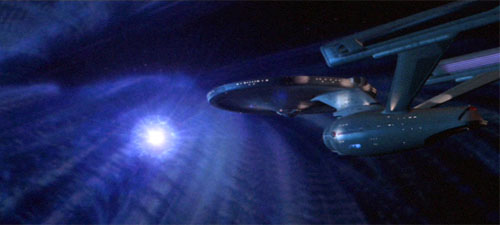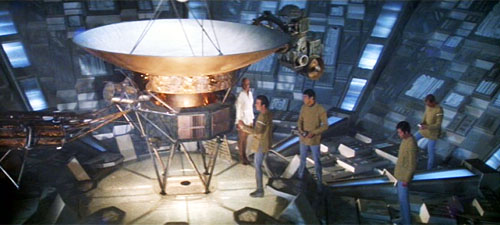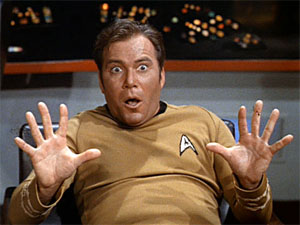 Well that break didn’t last long. I found myself pondering what to watch on a spare Friday evening and my hand drifted to Star Trek: The Motion Picture, the first movie entry in the series and the first new Star Trek since the TV series ended in 1969, ten years earlier. I remember this movie with some fondness, because it was the first Star Trek I got to see in first release, and on the big screen to boot. I remember being immersed in the wonder of spaceships and the pretty visuals. Being only a kid at the time I think the story was mostly lost on me.
Well that break didn’t last long. I found myself pondering what to watch on a spare Friday evening and my hand drifted to Star Trek: The Motion Picture, the first movie entry in the series and the first new Star Trek since the TV series ended in 1969, ten years earlier. I remember this movie with some fondness, because it was the first Star Trek I got to see in first release, and on the big screen to boot. I remember being immersed in the wonder of spaceships and the pretty visuals. Being only a kid at the time I think the story was mostly lost on me.
And that’s kind of how it appears in the canon now, in the ripeness of time. It’s a luscious visual feast and a nostalgic return to something already loved, but not a strong piece of film in its own right. It plods along and is cerebral rather than exciting. I have the Director’s Edition DVD (one of several recuts of the film to make it work better), which runs to 141 minutes on PAL (it’d be a solid 2 and a half hours on NTSC). The first 2 minutes and 50 seconds of that is an orchestral overture accompanied by a receding starfield image and nothing else. It feels like attending a concert. And I remember being grossly disappointed by that music when I first heard it in the cinema. I was hoping for a rendition of the theme from the TV series, but instead I got this… foreign, unfamiliar music. But that theme is now intimately familiar, as it was used as the theme music for Star Trek The Next Generation. And watching the movie again, I have to say that Jerry Goldsmith’s music is one of the highlights of the film. It’s given prominence by the many scenes in which nothing happens but panning and sweeping shots of space exteriors to the accompaniment of the music. You could almost close your eyes watching this film and enjoy it as much.
The overture eventually ends and we are treated to and opening scene of three Klingon vessels attacking a mysterious space cloud thing. Klingons!! Awesome, I remember, when I was that excited kid in the cinema seeing this for the first time. The movie was going to be a huge space shoot-out between Klingons and Captain Kirk on the Enterprise! What’s not to love?! (I was prejudiced somewhat by the recently released Star Wars, 2 years earlier.) Except it didn’t turn out that way. The Klingons are merely there to show how impossibly powerful and impervious this cloud thing is, as it destroys them each without lifting a cloudy muscle. The Klingons, by the way, are the first appearance of the modern brow-ridged variety, and look much cooler than the Klingons ever looked in the TV series.
There’s a scene of Spock on Vulcan, apparently failing some sort of ceremonial logic thingy. We switch to Starfleet Headquarters, which apparently has taken over the Presidio in San Francisco, where Kirk is revealed to be an Admiral, but is heading up to the newly refitted Enterprise to take command, as the hostile cloud thingy is headed straight for Earth. Kirk beams up to an orbital station – the transporters have been upgraded with late-1970s special effects and now take twice as long to do their job. We are treated to a full four and a half minutes of orchestral starship strip-tease as Scotty takes Kirk over to the Enterprise in a shuttlecraft, flying lovingly around the Enterprise in a sensual manner.
Kirk relieves Captain Decker of his command, setting up the only real tension in the movie. The crew are rushing to get the ship ready for departure, and not all the systems are working yet. This is demonstrated when Starfleet tries to beam science officer Sonak and another crew member directly on board, only for them to get mangled. In a welcome return, Janice Rand is now the transporter chief. When she gets the contraption working properly, the last crew member to beam aboard is a bearded and reluctant McCoy, who complains about having been drafted back into service. With his beard and giant gold pendant around his neck, he looks more like a Bee Gee than a doctor, dammit! Another crew member is the exotic Deltan navigator Ilia, who makes a bizarre comment about having an oath of celibacy on record with Starfleet. This makes sense when you know the back-story given in the novelisation (which I had and read, though it took me some years to figure out what “celibacy” meant) about Deltans producing human-affecting pheromones and being so sexually advanced that any human having sex with a Deltan would be consumed by addictive lust – but none of that is ever mentioned in the film, making it weird and inexplicable.
34 and a half minutes into the film, the Enterprise finally gets underway, with another 2 minutes of visual starship porn. A very cool feature of this Enterprise is that it is not lit by some mysterious ambient lighting that pervades space and conveniently illuminates space ships. It’s dark, and lit only by an appropriately directional light from the sun and exterior running lights. The ship looks fantastic. It heads out at Warp 0.5, passing Jupiter in 1.8 hours (which implies Warp 0.5 is about a quarter the speed of light). The problem is when they try the warp engines, which haven’t been tested since the refit. They produce a wormhole and the ship is in danger of being destroyed by an asteroid. Kirk tries to fire phasers, but Decker overrules him and uses a torpedo to destroy the asteroid, explaining later that the phasers now go through the warp drive, so wouldn’t have worked. 1-1 Kirk-Decker. McCoy is straight into his most important role – not doctor, but advisor to Kirk, telling not to push people so hard. It’s now that you become acutely aware that something is missing from the old team: Spock.
Cue the appearance of a mysterious long-range shuttle, which deposits Spock, fresh from Vulcan. He fixes the engines, then explains how he felt a “mind” calling to him from the mystery cloud. As they approach the cloud, Spock becomes more contemplative. The cloud fires at the Enterprise, injuring nobody but Chekov as his panel explodes. Another shot will destroy them, but Spock notices the cloud is using frequencies of “a million megahertz” (i.e. terahertz radiation), and broadcasts friendship messages at that frequency, which halts the attack. They spend another half an hour of screen time flying into the depths of the cloud, past lots of cool scenery. Eventually the cloud gets bored and probes the Enterprise, disintegrating Ilia. She reappears as a robotic reconstruction, assigned to investigate the “carbon units” (i.e. life forms) on board Enterprise. Decker draws the short straw of showing robo-Ilia around.
 Spock leaves the ship in a space suit to try to meld with the cloud’s mind, and comes back half dead, but with a story about it being perfectly logical, but with no sense of who it is. The cloud is curious and naive. Robo-Ilia says the cloud is named V’ger, and V’ger demands information about its creator, which for some reason it thinks is on Earth. If its creator does not respond, it will destroy all the carbon units on Earth. In typical style, Kirk bluffs, saying he needs to talk to V’ger personally to explain why the creator hasn’t responded. Robo-Ilia takes him, McCoy, Spock, and Decker out of the ship, across a Giant’s Causeway of hexagonal blocks, to a dilapidated but eerily familiar looking space probe. Kirk reads the name plate: “V—GER”, and brushes off the dirt to reveal “VOYAGER 6”, an Earth probe launched in the 20th century and lost into “what they used to call a black hole”. Apparently its programming was corrupted and it returned to Earth to seek what it thought was its creator and destroy everything else. Shades of Nomad, from the TV episode “The Changeling“, anyone? Anyway, they try transmitting the download code to V’ger, but it burns its own wiring out, forcing the creator to physically reconnect it and join with V’ger. Decker volunteers and melds with Robo-Ilia in a symbolic rebirth thing, leaving just the Enterprise and a saved Earth to fade into the end credits.
Spock leaves the ship in a space suit to try to meld with the cloud’s mind, and comes back half dead, but with a story about it being perfectly logical, but with no sense of who it is. The cloud is curious and naive. Robo-Ilia says the cloud is named V’ger, and V’ger demands information about its creator, which for some reason it thinks is on Earth. If its creator does not respond, it will destroy all the carbon units on Earth. In typical style, Kirk bluffs, saying he needs to talk to V’ger personally to explain why the creator hasn’t responded. Robo-Ilia takes him, McCoy, Spock, and Decker out of the ship, across a Giant’s Causeway of hexagonal blocks, to a dilapidated but eerily familiar looking space probe. Kirk reads the name plate: “V—GER”, and brushes off the dirt to reveal “VOYAGER 6”, an Earth probe launched in the 20th century and lost into “what they used to call a black hole”. Apparently its programming was corrupted and it returned to Earth to seek what it thought was its creator and destroy everything else. Shades of Nomad, from the TV episode “The Changeling“, anyone? Anyway, they try transmitting the download code to V’ger, but it burns its own wiring out, forcing the creator to physically reconnect it and join with V’ger. Decker volunteers and melds with Robo-Ilia in a symbolic rebirth thing, leaving just the Enterprise and a saved Earth to fade into the end credits.
It’s not a bad story. It’s just… watching it is a very… leisurely experience. There are several nice scenes. The music is good and the special effects are very nice for the 1970s. The story makes more sense in the novelisation, where it actually has some exposition. There are themes that could have been explored here – the relations between the power trio of Kirk, Spock, and McCoy in particular – that aren’t developed until the following films. It’s not terrible, but it’s not great. About the same as a mid-range TV episode – about the same as “The Changeling”, in fact.
Tropes: Kicked Upstairs, Leave The Camera Running, Teleporter Accident, Mandatory Unretirement, Our Wormholes Are Different, Putting The Band Back Together, Russian Guy Suffers Most, Robot Girl, Machine Monotone, Recycled Script, Ascend To A Higher Plane Of Existence.
Body count: Crew of three Klingon battle cruisers, entire personnel of Epsilon IX station (all vapourised by V’ger), Commander Sonak, unnamed female crew member (both mutated in transporter accident), Lieutenant Ilia (zapped by V’ger), Commander Decker (officially listed as “missing”).
 We are on our flight from Lima to Puerto Maldonado, with a stop in Cusco on the way. We got up at 05:50 to get the breakfast Ale had said would be arranged for us at 06:00. But there was nobody else there and only bread rolls and a jug of orange juice there – no fruit or cereal or yoghurt. We had some bread rolls with our malaria tablets, and a guy came out to put plates of ham and cheese out – he looked surprised to see us there. We went to pack our bags and be downstairs by 06:45 for our bus to the airport with the others, except for Lyn and Gary, Zaina and Zeeshan, who were booked on a later flight and so got to sleep in. Our bonus for getting to Puerto Maldonado before them is a short trip to a local market before we meet up with them before our boat trip to the jungle lodge.
We are on our flight from Lima to Puerto Maldonado, with a stop in Cusco on the way. We got up at 05:50 to get the breakfast Ale had said would be arranged for us at 06:00. But there was nobody else there and only bread rolls and a jug of orange juice there – no fruit or cereal or yoghurt. We had some bread rolls with our malaria tablets, and a guy came out to put plates of ham and cheese out – he looked surprised to see us there. We went to pack our bags and be downstairs by 06:45 for our bus to the airport with the others, except for Lyn and Gary, Zaina and Zeeshan, who were booked on a later flight and so got to sleep in. Our bonus for getting to Puerto Maldonado before them is a short trip to a local market before we meet up with them before our boat trip to the jungle lodge.

 Well that break didn’t last long. I found myself pondering what to watch on a spare Friday evening and my hand drifted to
Well that break didn’t last long. I found myself pondering what to watch on a spare Friday evening and my hand drifted to  Spock leaves the ship in a space suit to try to meld with the cloud’s mind, and comes back half dead, but with a story about it being perfectly logical, but with no sense of who it is. The cloud is curious and naive. Robo-Ilia
Spock leaves the ship in a space suit to try to meld with the cloud’s mind, and comes back half dead, but with a story about it being perfectly logical, but with no sense of who it is. The cloud is curious and naive. Robo-Ilia 
 “Turnabout Intruder” is the last episode of Star Trek, and what a dismal ending.
“Turnabout Intruder” is the last episode of Star Trek, and what a dismal ending.